织物疵点检测
- 格式:pdf
- 大小:101.01 KB
- 文档页数:4

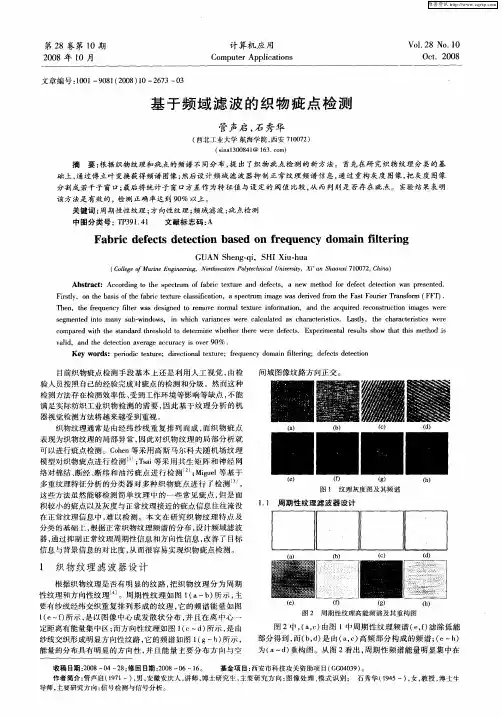
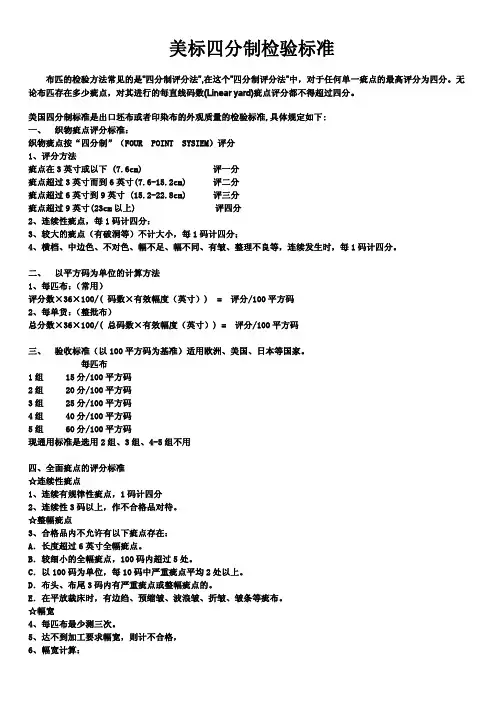
美标四分制检验标准布匹的检验方法常见的是"四分制评分法",在这个"四分制评分法"中,对于任何单一疵点的最高评分为四分。
无论布匹存在多少疵点,对其进行的每直线码数(Linear yard)疵点评分都不得超过四分。
美国四分制标准是出口坯布或者印染布的外观质量的检验标准,具体规定如下:一、织物疵点评分标准:织物疵点按“四分制”(FOUR POINT SYSIEM)评分1、评分方法疵点在3英寸或以下(7.6cm)评一分疵点超过3英寸而到6英寸(7.6-15.2cm)评二分疵点超过6英寸到9英寸(15.2-22.8cm)评三分疵点超过9英寸(23cm以上)评四分2、连续性疵点,每1码计四分:3、较大的疵点(有破洞等)不计大小,每1码计四分;4、横档、中边色、不对色、幅不足、幅不同、有皱、整理不良等,连续发生时,每1码计四分。
二、以平方码为单位的计算方法1、每匹布:(常用)评分数×36×100/(码数×有效幅度(英寸))=评分/100平方码2、每单货:(整批布)总分数×36×100/(总码数×有效幅度(英寸))=评分/100平方码三、验收标准(以100平方码为基准)适用欧洲、美国、日本等国家。
每匹布1组15分/100平方码2组20分/100平方码3组25分/100平方码4组40分/100平方码5组60分/100平方码现通用标准是选用2组、3组、4-5组不用四、全面疵点的评分标准☆连续性疵点1、连续有规律性疵点,1码计四分2、连续性3码以上,作不合格品对待。
☆整幅疵点3、合格品内不允许有以下疵点存在:A.长度超过6英寸全幅疵点。
B.较细小的全幅疵点,100码内超过5处。
C.以100码为单位,每10码中严重疵点平均2处以上。
D.布头、布尾3码内有严重疵点或整幅疵点的。
E.在平放裁床时,有边绉、预缩皱、波浪皱、折皱、皱条等疵布。
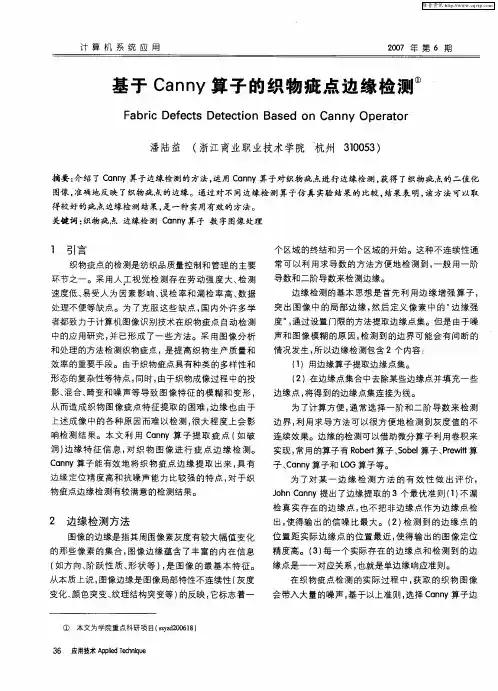
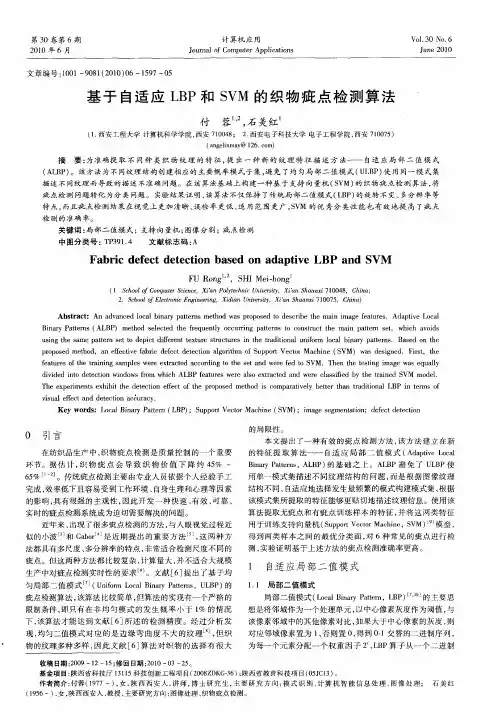
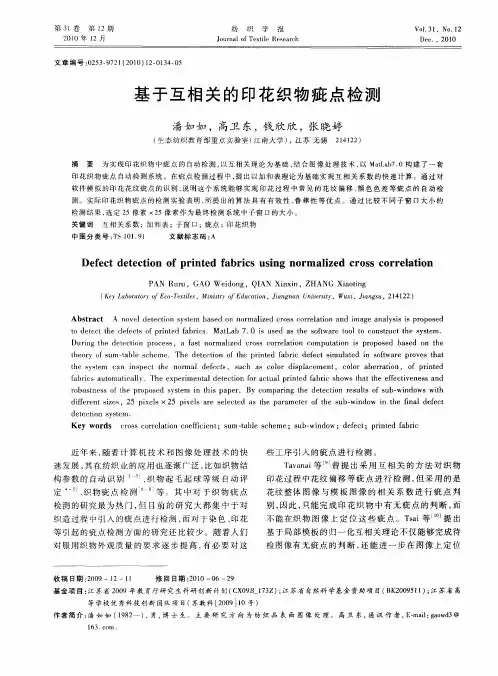
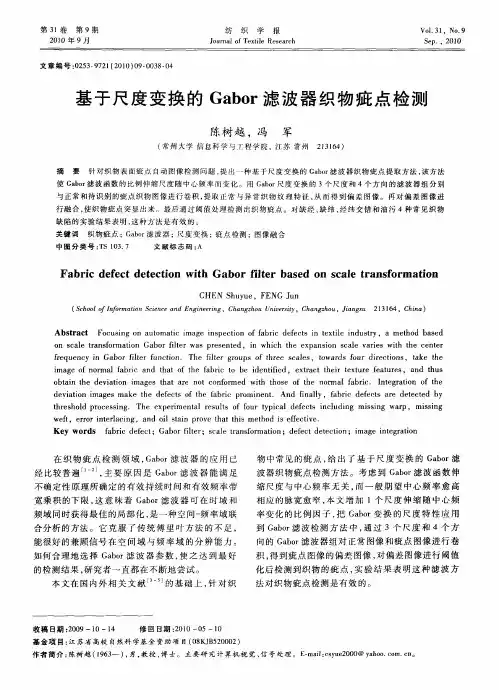
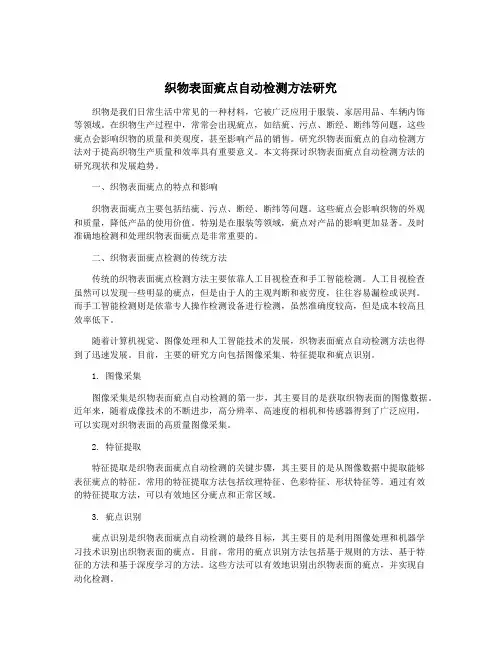
织物表面疵点自动检测方法研究织物是我们日常生活中常见的一种材料,它被广泛应用于服装、家居用品、车辆内饰等领域。
在织物生产过程中,常常会出现疵点,如结疵、污点、断经、断纬等问题,这些疵点会影响织物的质量和美观度,甚至影响产品的销售。
研究织物表面疵点的自动检测方法对于提高织物生产质量和效率具有重要意义。
本文将探讨织物表面疵点自动检测方法的研究现状和发展趋势。
一、织物表面疵点的特点和影响织物表面疵点主要包括结疵、污点、断经、断纬等问题。
这些疵点会影响织物的外观和质量,降低产品的使用价值。
特别是在服装等领域,疵点对产品的影响更加显著。
及时准确地检测和处理织物表面疵点是非常重要的。
二、织物表面疵点检测的传统方法传统的织物表面疵点检测方法主要依靠人工目视检查和手工智能检测。
人工目视检查虽然可以发现一些明显的疵点,但是由于人的主观判断和疲劳度,往往容易漏检或误判。
而手工智能检测则是依靠专人操作检测设备进行检测,虽然准确度较高,但是成本较高且效率低下。
随着计算机视觉、图像处理和人工智能技术的发展,织物表面疵点自动检测方法也得到了迅速发展。
目前,主要的研究方向包括图像采集、特征提取和疵点识别。
1. 图像采集图像采集是织物表面疵点自动检测的第一步,其主要目的是获取织物表面的图像数据。
近年来,随着成像技术的不断进步,高分辨率、高速度的相机和传感器得到了广泛应用,可以实现对织物表面的高质量图像采集。
2. 特征提取特征提取是织物表面疵点自动检测的关键步骤,其主要目的是从图像数据中提取能够表征疵点的特征。
常用的特征提取方法包括纹理特征、色彩特征、形状特征等。
通过有效的特征提取方法,可以有效地区分疵点和正常区域。
3. 疵点识别疵点识别是织物表面疵点自动检测的最终目标,其主要目的是利用图像处理和机器学习技术识别出织物表面的疵点。
目前,常用的疵点识别方法包括基于规则的方法、基于特征的方法和基于深度学习的方法。
这些方法可以有效地识别出织物表面的疵点,并实现自动化检测。
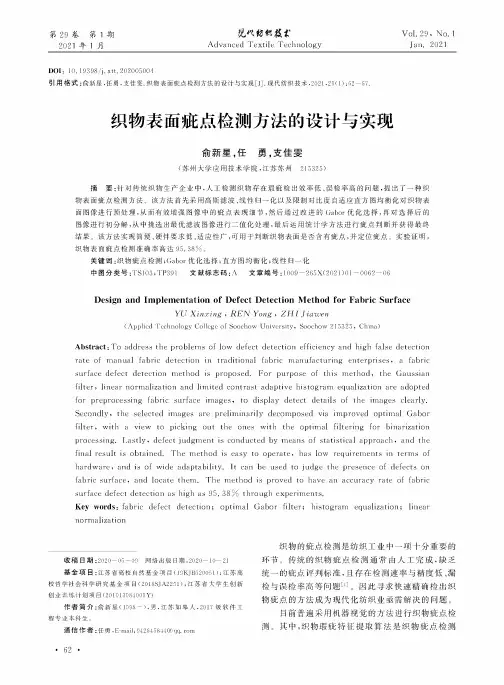
Vol. 29, No. 1Jan. 2021第29卷第1期2021年1月AdvancedTextileTechnologyDOI : 10. 19398/j. a t 202005004引用格式:俞新星,壬勇,支佳雯.织物表面疵点检测方法的设计与实现现代纺织技术,021,9():62 — 67.织物表面疵点检测方法的设计与实现俞新星,任勇,支佳雯(苏州大学应用技术学院,江苏苏州215325)摘要:针对传统织物生产企业中,人工检测织物存在瑕疵检出效率低、误检率高的问题,提出了一种织物表面疵点检测方法。
该方法首先采用高斯滤波、线性归一化以及限制对比度自适应直方图均衡化对织物表面图像进行预处理,从而有效增强图像中的疵点表现细节,然后通过改进的Gabor 优化选择,再对选择后的图像进行初分解,从中挑选出最优滤波图像进行二值化处理,最后运用统计学方法进行疵点判断并获得最终结果。
该方法实现简便、硬件要求低、适应性广,可用于判断织物表面是否含有疵点,并定位疵点。
实验证明,织物表面疵点检测准确率高达95.38%.关键词:织物疵点检测;Gabor 优化选择;直方图均衡化;线性归一化中图分类号:TS103;TP391文献标志码:A 文章编号:1009— 265X(202 1 )01 —0062— 06Design and Implementation of Defect Detection Method for Fabric SurfaceYU Xinxing , REN Yong , ZHI Jiawen(Applied Technology College of Soochow University, Soochow 21 5325 , China)Abstract : To address the problems of low defect, detection efficiency and high false detectionrateof manualfabric detectionin traditionalfabric manufacturing enterprises ,a fabric surface defect, detection method is proposed. For purpose of this method , the Gaussianfilter , linear normalization and limited contrast, adaptive histogram equalization are adopted for preprocessing fabric surface images , to display detect details of the images clearly.Secondly , the selected images are preliminarily decomposed viaimproved optimal Gaborfilter ,with a view to picking outthe ones with the optimalfiltering for binarization processing. Lastly, defect, judgment, is conducted by means of statistical approach , and thefinalresultisobtained.The methodiseasytooperate ,haslow requirementsintermsof hardware , and is of wide adaptability. It can be used to judge the presence of defects onfabricsurface ,andlocatethem.The method is proved to have an accuracy rate of fabric surfacedefectdetectionashighas95.38% throughexperiments.Key words :fabric defect detection ;optimal Gabor filter ; histogram equalization ;linearnormalization收稿日期:2020 —05 —09网络出版日期:2020 —10 —21基金项目:江苏省高校自然基金项目(19KJB520051);江苏高校哲学社会科学研究基金项目(2018SJA2251);江苏省大学生创新创业训练计划项目(201913984009Y)作者简介:俞新星(1998 — )男,江苏如皋人,2017级软件工程专业本科生。
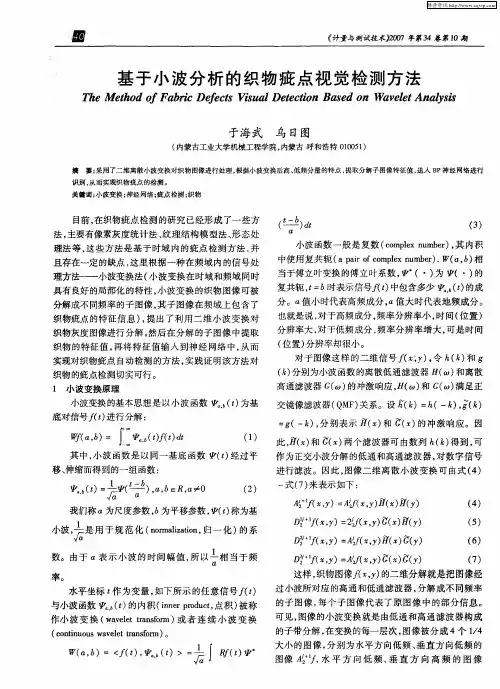
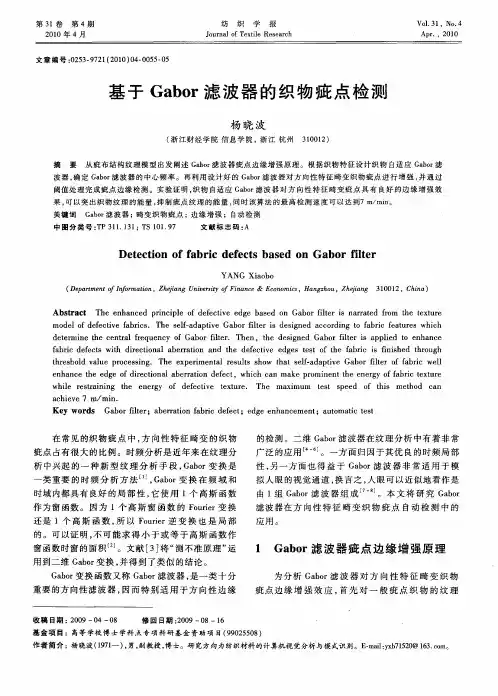
织物表面疵点自动检测方法研究织物表面疵点是制造中不可避免的问题,在纺织品生产过程中,织物表面经常会出现疵点、结、线头等问题,这些问题会影响织物的外观质量,进而影响产品的价值。
因此,自动检测织物表面疵点的方法对于维护产品质量具有重要意义。
本文将介绍一种基于图像处理技术的织物表面疵点自动检测方法。
首先,需要获取织物表面的图像。
一般可以使用数码相机或者线扫描仪等设备来获取高质量的织物表面图像,对于不同的设备和工艺条件,需要选择不同的图像获取方法。
对于线扫描仪这种设备,可以通过多次扫描来获取一定长度的图像,提高图像的分辨率,并且可以利用扫描仪的高速度优势,提高生产效率。
接下来,需要对织物表面图像进行预处理。
由于织物表面的光线和颜色变化较大,会影响后续的图像处理,因此需要对原始图像进行预处理。
预处理的主要步骤包括调整图像的亮度和对比度,去噪,平滑和锐化等。
预处理后的图像能够更好地反映织物表面的特征,便于后续的图像分析和处理。
接着,需要对预处理后的图像进行分割,将织物表面中的纤维和疵点等区域分开。
采用的图像分割算法主要包括基于阈值的分割算法、边缘检测算法、区域生长算法和聚类算法等。
对于纤维区域和疵点区域的分割,可以采用不同的分割算法,权衡算法的复杂度和分割效果,使得分割结果能够更好地反映织物表面的纹理和结构。
在分割后,需要对纤维和疵点等区域进行特征提取,根据不同的特征及其组合,将其与真实图像进行分类,完成织物表面疵点的自动检测。
常用的特征包括颜色、纹理、形状等信息,特征提取的方法包括Gabor滤波器、小波变换、灰度共生矩阵等多种方法。
可以利用机器学习、人工神经网络等方法构建分类器,训练样本和测试样本的数量和质量越高,检测的准确性就越高。
本文介绍了一种基于图像处理的织物表面疵点自动检测方法,该方法能够准确、高效地检测织物表面中的疵点,便于对生产过程进行监控和质量管理。
未来,可以进一步将图像处理技术与传感器技术、人工智能技术等相结合,开发更加智能、高效的织物表面疵点自动检测系统,为纺织品行业的发展提供更好的技术支持。
基于上下文信息的多尺度特征融合织物疵点检测算法在纺织工业的庞大生产线上,疵点的检测犹如大海捞针,既复杂又耗时。
然而,随着科技的飞速发展,一种名为“基于上下文信息的多尺度特征融合织物疵点检测算法”的技术应运而生,它就像是纺织界的“侦探”,专门负责揭露隐藏在织物深处的瑕疵。
这项技术的核心在于其独特的“多尺度特征融合”能力。
想象一下,你正在用放大镜观察一幅画,从整体到局部,从轮廓到细节,你的眼睛不断调整焦距,以捕捉画面的每一个角落。
同样,这种算法也能在不同的尺度上扫描织物,无论是大片的色差还是微小的线头,都逃不过它的“法眼”。
而且,这位“侦探”还拥有一项绝技——“上下文信息分析”。
在传统的疵点检测中,算法往往只关注单一的像素或区域,而忽略了周围环境的影响。
但在我们的生活中,判断一个事物是否异常,往往需要结合周围的情境。
这种算法正是借鉴了这一原理,通过分析疵点周围的纹理、颜色等上下文信息,来判断其是否真正属于疵点。
那么,这位“侦探”是如何工作的呢?首先,它会对输入的织物图像进行预处理,去噪、增强对比度等操作,为后续的检测打下良好基础。
接着,它会在多个尺度上提取织物的特征,包括纹理、颜色、形状等。
这些特征就像是“侦探”手中的线索,帮助它逐步锁定目标。
然后,利用深度学习等先进技术对这些特征进行融合和分析,最终得出是否存在疵点以及疵点的具体位置。
值得一提的是,这种算法还具有很强的适应性和扩展性。
无论面对的是棉布、丝绸还是化纤等不同材质的织物,它都能从容应对。
同时,随着技术的不断进步和数据的积累,它的检测精度和速度也将得到进一步提升。
当然,任何技术都不是完美的。
这种算法虽然在织物疵点检测领域取得了显著成果,但仍面临着计算资源消耗大、实时性有待提高等挑战。
但我相信,在科研人员的不懈努力下,这些问题终将得到解决。
总的来说,“基于上下文信息的多尺度特征融合织物疵点检测算法”就像是纺织界的一位智慧“侦探”,以其敏锐的洞察力和强大的分析能力,为纺织工业的质量控制带来了革命性的突破。
纺织品国际四分制检验标准及疵点分析对于出口面料验货标准, 许多国家尤其欧美国家都要求用国际四分制验货,具体验货标准如下:一、等级规则1、疵点小于 3英寸的扣一分;2、疵点大于等于 3英寸小于 6英寸的扣两分;3、疵点大于等于 6英寸小于 9英寸的扣三分;4、疵点大于等于 9英寸的扣四分。
5、在规则中,单个疵点最高扣分不得超过四分,无论疵点大小。
6、任何一码扣分不得超过四分,无论疵点多少。
7、任何一码中的严重疵点无论在任何位置都要扣四分。
如破洞,不论大小,均扣四分。
8、对连续性疵点,如边到边疵点、边中差、匹差、幅宽不匀、折痕、处理不匀等,每一码均扣四分。
9、任何一卷布中,如果有超过连续三码布有连续重复疵点,则此卷为不合格产品。
10、任何一卷中,如开始或最后三码含有较严重疵点(指三分或四分疵点 ,则此卷不合格。
11、按常规方法平铺时,如果植物两边或一边有明显的松紧现象,或有波纹,皱褶,折痕等疵点,则为不合格。
12、按 AATCC 灰色分级样卡, ,卷与卷或匹与匹之间色差不得低于四级。
13、按照 AATCC 灰色分级样卡,边边色差,边中色差及头尾色差不得低于四级。
14、大货样与客户提供确认的标样色差不得低于四级。
15、所检验每卷布要取 6-10英寸宽全幅批条,一般寄客户,一般留档。
16、计分标准, 麻类混纺织物单卷 40分 /100平方码,平均装运 32分 /100平方码;纯麻类织物单卷 60分 /100平方码,平均装运 48分 /100平方码; 棉类产品单卷 28分 /100平方码, 平均装运 20分 /100平方码。
超过此分级为不合格产品。
记分方法:100平方码罚分 =单卷罚分 x 3600/可裁剪幅宽(英寸 /单卷码数。
17、所有疵点都需用丝线在布边相应位置标明。
18、打卷时每卷允许有多个接头,但每个段长不得少于 30码,除非合同中允许小段长卷入。
19、纬斜超过 3%的为不合格产品。
20、每卷不得手感如有明显差异,则此卷为不合格。
DEFECT DETECTION IN REPETITIVE FABRIC PATTERNSR.PerezComputer Engineering Technical University of Valencia Ferrandiz y Carbonell no.2Alcoy,Spain. email:ruperez@disca.upv.esJ.SilvestreComputer EngineeringTechnical University of Valenciaemail:jsilves@disca.upv.esJ.MunozInstituto Tecnologico TextilEmilio Sala no.1Alcoy,Spainemail:jmunoz@aitex.esABSTRACTIn this paper a automated analysis system for defect de-tection in the print process offlocked fabrics with repet-itive patterns is presented.This process represents a less computationally complex method than the detection of any type of pattern in the print process.For this reason,this problem can be solved using a personal computer(PC)in-specting100%of the production that fulfill the require-ments of repetitive patterns.This system will be extremely useful for companies which produce repetitive pattern tex-tiles in large quantities.The implementation of a prototype system,based on the Fast Fourier Transform,will be de-scribed.KEY WORDSTextile Inspection,Fast Fourier Transform1IntroductionIn spite of the advantages that computer vision provides to the fabric inspection process,in the production stage as well asfinal inspection,this technology has had little impact on the textile sector when considering developed systems,research articles and research institute projects. Meier[1]points out that although no electronic system is equal to the human eye,there are disadvantages.These include concentration,reproducibility of the process,es-pecially with the entire width of the fabric,speed and spe-cial functions:analyzing the size,form,configuration,con-trast and relevancy of the defect to thefinality of the prod-uct.However,the textile industry employs computer vision very little because:•Visual inspection of irregularities is complex due to the fact that the product is sometimes irregular by na-ture.The textile process can vary significantly and it can still be considered correct.•Fabric materials areflexible and can easily be dis-torted,which makes it difficult to use standard meth-ods for automated inspection.•The economic cost it is possibly greater in this sec-tor than in others,because of the size of the area to be inspected and the resolution required to detect the defects.For these reasons,the development of systems governed by these restrictions,capable of detecting errors visible to the human eye,are quite expensive.Nevertheless,there have been serious attempts by researchers to introduce these techniques in the textile sector.For example,in regular texture fabrics analysis,Shin[2]develops an algorithm for defect detection and classification based on energy mea-sures and the adaptive mask theorem.Although this needs the design of a classifier using test data,it is not a gener-ally accepted method(Campbell[3-6])due to the impos-sibility of obtaining representative defect data with all er-ror characteristics.Cohen[7]develops a system based on a Gaussian Markov Random Field(GMRF)model of the correct textile texture,using non-overlapped windows to extract the GMRF parameters and compare it using a clas-sifier,with the correct characteristics of the fabric texture to determine the correctness of the window.Other work on texture defect detection can be seen in papers by Camp-bell[3-6]and Balakrishnan[8],based on Fourier Trans-form and where they also offer an interesting description of the fabric problems,Hoffer[9]uses an Optic Fourier Trans-form(OFT),Lewis[10],develops a Fourier based method using multiresolution decomposition by wavelets,and Es-cofet[11]uses the Fourier Angular Spectra Correlation to detect global defects and Gabor Filters to detect local de-fects.This paper is organized as follow:In section2we explain the problems and their particularities,in section3 we present the developed algorithm and in section4the results and the conclusions are shown.2Problem descriptionIn the textile industry,the print process is the way in which a particular substance,usually dye,is impregnated on to a fabric in some areas using a perforated cylinder with holes positioned to give the desired design.A cylinder is used for each colour in the process.The most common problem in this process is the obstruction of the cylinder holes by dust, solidification of the dye,etc.so that the resulting design is faulty.In theflocked fabrics industry,it is normal proce-dure to use this process to makeflocked drawings on fabric bases.The colour of the fabric bases is usually the same as theflock to be printed,as well as the adhesive used tofix theflock to the weave.Therefore,although this process ofproduction is usually slower that the normal fabric printing processes and only works with one colour,it presents a se-rious disadvantage to the inspection of defects by the work-ers.This disadvantage is that all the elements used have the same colour,which makes detection very difficult.When considering that up to10,000meters of the same design and colour can be produced,it is easy to see the importance of automatic detection of the printing defects.The system has to detect the defects produced in the print process of the adhesive on the fabric bases,so that later theflock adheres to the desired areas.The system designed does not require hi-res images since the geometric patterns are not exactly equal.In addition,when the adhesive fails in a small area, the adhesion process masks this so it is imperceptible in thefinished product.Another factor introduced by the im-perfection of the textile geometric designs and what it is tried to avoid in the stamping process when the defect is detected,it will be signalled to the operator,who can clean the cylinder in the area indicated.Thus,the defect is cor-rected and the number of defective meters is minimized. 3Approach3.1HardwareFor the detection of defects,a colour linear camera of2048 pixels has been used,which provides sufficient resolution for a fabric analysis of1,60meters.For the illumination system,due to the opacity of the fabric base,a front light system need to be used,that provides an adequate contrast between the fabric and adhesive,obtaining therefore im-ages where the design can be appreciated.3.2Developed algorithmThe algorithm used is based on the calculation of the fast Fourier Transform(FFT)on windows throughout all the image.To each one of these windows the forward FFT is applied,and then frequencies arefiltered using a mask on the transformed image.Once the image isfiltered,the inverse transform is applied to obtain thefiltered real im-age in which the defects appear as a white or dark spots, as thefiltering process removes the repetitive pattern.In a post process stage,the repetition of these defects is ana-lyzed since those that are repeated in all rapports constitute significant defects for the company.3.2.1Windowing processThe FFT window size is set to256pixels.Different win-dow sizes were tested and the best results were obtained using this window size with the resolution used.To con-struct the windows,a superimposition among them has been made so that only the central part of the inversed im-ages is processed,avoiding edge problems on the FFT win-dow.For the overlapping of the different FFT windows,it has been taken into account that the quantity of windows to process covers the whole image plus an external border similar to the overlapping which exists between the rest of the windows.This external border added to the original image avoids border problems in the margins of the image. This extra border which together with the rest of the image we will call amplified image,isfilled with the inverted im-age which we analyse.Infigure1the windowing process can be seen with the overlapping of thewindows.Figure1.FTT Windows on aflock adhesive image.The contrast has been exaggerated3.2.2Windows processingOnce the windowing process of the image is calculated,the FFT is done on each ter,the necessary calcu-lations are made to obtain thefilter mask that will elimi-nate the frequencies whose module is superior to a certain threshold value,which will belong to the repetitive pattern that appears in the printing.For this,firstly the module of the transformed image is calculated and then the logarithm is applied to obtain a higher contrast transformed image.A histogram of the resulting image is calculated to select a percentage of the existing frequencies.In the tests,this percentage oscillated around15%.In other words,for the filtering,the algorithm will choose to eliminate a percent-age of the frequencies that dynamically exceed a threshold obtained from the windows analysis.Once the threshold has been obtained,these frequencies are eliminated and the inverse transform is applied again to obtain thefiltered im-age.3.2.3Post-processingAfter thefiltered image is obtained,the post-processed one is calculated,which includes the detection of possible de-fects and if this has been repeated.For the detection of possible defects,a similar method to the FFTfiltering is used.The image histogram is calculated and is analyzed to remain with a certain percentage of pixels.Then the image is thresholded,the isolated background noise pixels appear, and only one pixel sized items are removed,since the real defects always have a greater size.When we have the real defects that appear in the im-age,itfinds out if they are significant defects for the com-pany or not.In this case,a defect is only significant,if itrepeats during all rapports,since these take place by the ob-struction of some of the points of the cylinder injector.If the defect is not repeated,the obstruction has disappeared by itself and it does not make sense to stop production to correct it.For that reason,when we detect a defect,it is analyzed and only if this has already appeared in previous rapport is the defect marked to be significant.If the defect is new,it is stored so that its possible repetition can be ver-ified.If the defect doesn’t appear in the following rapports, it will be eliminated because it is not considered significant.3.2.4ImplementationThe inspection system has two different parts:The me-chanical structure and the hardware that are responsible for the correct acquisition of the images of the fabric,and the software application that does all the processing,analysis and possible actions to be taken.The system has to analyze all the fabric,and when some relevant defects are found(as has been commented previously,in the case of the print-ing,the relevant defects are those that take place in each rapport and not in a sporadic form),the machine can make the decision to stop production so that the worker can clean the stamping roller.When the machine starts to analyze the fabric,the program starts a thread to do the acquisition of the images and whenever a new image is acquired,another thread is started to process the frame.This thread analy-ses the image using the technique explained in the previ-ous section and gives back a report with the possible errors found on it.Another problem found,is due to the use of a linear camera that causes due to optical and luminance rea-sons,that the ends of the image always appear darker than the central part.Nevertheless it is a smaller problem since the change of intensity for this reason isfixed and known. To solve this problem,a correction vector is captured from a white image and is stored and used later to correct all the acquisitions.The designed prototype can work as well in colour images,as in black and white images,although the optimal results are obtained normally using colour images. Although the captured image is a colour one,the analysis is made with a black and white transformed image.For the conversion,an algorithm of maximum contrast is used that gives very good results even with the mixtures of difficult colours such as blue or black base with black design.Infig-ure2,there is a dark green color design,with the correction and contrast stretch at the bottom.Once the corrected im-age is made,the different windows are calculated to do the FFT and,thenfilter it,as has been explained in the previous section.Infigure3,thefiltered result of the whole image can be observed.In the image,a black point is appraised that exactly represents the defect that exists in the design and that thefiltration heightens when eliminating the rest of the repetitive design of thepattern.Figure2.ImageCorrectionFigure3.FTT Filtered Image4Results and ConclusionsIn thefigure4,the defects detected by the system are shown.There are a lot of repetitive patterns that have been tested correctly by thefiltration algorithm.As can be seen in the images,the proposed algorithm works very well with all the tested designs even with very slight imperfections and strange asymmetric designs.It also has been tested with a wide colour spectra,including colours difficult to the human eye such as dark blue adhesive with dark blue weave,and black on black,and the results are good.5References[1]R.Meier,J.Uhlmann,R.Leuenberger.El sistema auto-matico de inspeccion para tejidos.Revista de la Industria Textil,Zellweger Uster,375,2000.[2]Shaw-jyh Shin,I-Shou Tsai,Po-Dong Lee.Feng Chia.Automatic faults detection and recognition for static plain fabrics.I nt.Journal of Clothing Science and Tech-nology.8(1/2),56-65.[3]J.G Campbell,Fionn Murtagh.Automatic Visual Inspection of Woven Textiles Using a Two-stage Defect Detector.Optical Engineering,37(9),1998,2536-2542.[4]J.G.Campbell,A.A.Hashim,T.Martin,McGin-nity Thomas,F.Lunney.Flaw Detection in woven tex-tiles by neural network.N eural Networks Conference, Maynooth,1995,92–99.[5]J.G.Campbell,A.A.Hashim,F.D.Murtagh.Flaw Detection in Woven Textiles using Space-dependet Fourier Transform.Irish Signals and Systems Conference,London-derry,N.Ireland,1997,500-506.[6]J.G.Campbell, C.Fraley, F.Murtagh, A.E. Raftery.Linear Flaw Detection in woven textiles usingFigure4.Examples of Defect DetectionModel-based Clustering.Irish Machine Vision and Image Processing Conference,Londonderry,N.Ireland,1997, 241-252.[7]F.S.Cohen,Zhigang Fan,Stephane Attali.Auto-mated Inspection of Textile Fabrics Using Textural Models. IEEE Transactions on Pattern Analysis and Machine Intel-ligence,13(8),1991,803-808.[8]H.Balakrishnan,S.Venkataraman,S.Jayaraman. FDICS.A Vision-based System for the Identification and Classification of Fabric Defects.Journal of Textile Insti-tute,1998.[9]Lois M.Hoffer,Franco Francini,B.Tiribilli,G. Longobardi.Neural networks for the optical recognition of defects in cloth.Optical Enginers,35(11),1996,3183-3190.[10]J.Lewis Dorroty,G.Vachtsevanos,Warren Jasper.Real-Time Fabric Defect Detection and Control in Wearing Processes.National Textile Center Annual Report, Georgia Institute of Technology,North Carolina State Uni-versity,1995,143-152.[11]lan,J.Escofet,J.Pladellorens,R. Navarro.Recognition and Inspection of Textile webs us-ing Fourier Analysis and Gabor Filters.VII National Symposium on Pattern Recognition and Image Analysis, Barcelona,Spain,1997,299-304.。